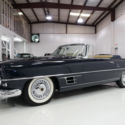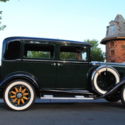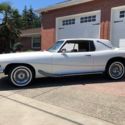1931 Stutz DV32 Convertible Victoria Rollston - Pebble Class Winner!
- Price:
- Location: Oakland, CA, United States
- Condition: Used
- Make: Other Makes
- Model: Stutz DV-32
- SubModel: Convertible Victoria
- Type: Convertible
- Trim: Convertible Victoria
- Year: 1931
- Mileage: 200
- VIN: MBPC1179
- Color: Gray
- Engine size: DOHC 32 Valve 8
- Number of cylinders: 8
- Transmission: Manual
- Drive type: 4 Speed
- Interior color: Brown
- Options: Convertible, Leather Seats
- Vehicle Title: Clear
1931 Other Makes Stutz DV-32 Convertible Victoria Description
View our eBay StoreSign up for our Email Newsletter1931 Stutz DV-32 Convertible Victoria Offered as a buy-it-now. Make us an offer!
This very rare car is one of only 7 Rollston Convertible Victoria's built on a Stutz Chassis. The car was first discovered in Cleveland in the 50's with a Chrysler 8 installed in place of its Original SV16 Motor. The car passed through a few hands prior to landing with its present owner, one of whom sourced the DV32 Motor currently in the car. The current owner embarked on a no expense spared top flite restoration with great care and attention to accuracy and authenticity-this car is correct down to the last detail. Not surprisingly, the car was chosen to participate in the prestigious Pebble Beach Concours where it received a Class Award, and it has also received a First Primary and First Senior in CCCA judging.
Finished in a striking yet tasteful color combination, this is certainly one of the most important Stutz in existence. The Rollston Convertible Victoria represents the pinnacle of Stutz Design during the halcyon peak of the Classic Era, and is without a doubt the most desirable and elegant bodies ever executed on the Stutz Chassis.
This is a rare opportunity to acquire an important piece of Automotive History that can comfortably serve as the centerpiece of any collection of important Pre War masterpieces.
We have many more photographs of this car, please click on any image to be taken to our full-size image list!
Stutz was founded as the Ideal Motor Car Company in Indianapolis IN in 1911. Ideal entered a car in the Indianapoli s 500that year and placed 11th, earning it the slogan, "the car that made good in a day". The next year, the founder, Harry C Stut, renamed the company Stutz Motor Company and began selling high-performance roadsters like the famous Stutz Bearcat. The Bearcat featured a brawny 4-cylinder T-head engine with four valves per cylinder, one of the earliest multi valve engines. Stutz was forced to raise money to fund his automobile production, eventually selling the company in 1919 after a falling out with the company's major stockholders, Allen Ryan, who then went bankrupt.
In 1922, three Stutz investors, one of whom was Charles Schwab, gained control of the company. The new owners brought in Frederick Moskowics, formerly of Daimler Benz, Marmon, and Franklin, in 1923. Moskowics quickly refocused the company as a developer of safety cars, a recurring theme in the auto industry. In the case of Stutz, the car featured safety glass, a low center of gravity for better handling, and a hill-holding transmission called "Noback".
One notable advance was the 1931 DOHC 32-valve in-line 8 (designed by Fred Duesenberg), called the "DV32" (DV for 'dual valve'). This was during the so-called "cylinders race" of the early 1930s, when makers of expensive cars were rushing to produce multi-cylinder engines. While Stutz did not have the resources to design and tool a new engine, the DV32 did allow them to their cars with a larger number than any of its competitors, who were advertising 12- and 16-cylinder engines in their own cars.
In 1927, a Stutz set a world record for speed, averaging 68 mph for 24 hours. The following year, a 4.9 litre Stutz in the hands of by Robert Bloch and Edouard Brisson finished second at the 24 Hours of LeMans to the 4.5 litre Bentley of Rubin and Barnato, despite losing top gear 90 minutes from the flag, the best result for an American car until 1966. That same year, development engineer and racing driver Frank Lockhartused a pair of supercharged 91ci DOHC engines in his Stutz Black Hawk Special streamliner Land Speed Record car, while Stutz set another speed record at Daytona, reaching 106.53 mph in the hands of Gil Anderson. In 1929, three Stutzes, with bodies designed by Gordon Buehrig, built by Weymann's U.S. subsidiary, and powered by a 155 HP 322ci superchargred straight 8 ran at Le Mans, piloted by Edouard Brisson, George Eyston, and co-drivers Phillippe de Rothschild and Guy Bouriat; de Rothschild and Bouriat placed fifth after the other two cars fell out with split fuel tanks. Production ended in 1935 after 35,000 cars had been manufactured.
The former Indianapolis factory is today known as the Stutz Business Center and is home to more than eighty artists, sculptors, photographers, designers, architects, and craftsmen.
Despite the relatively high production figure mentioned above, less than 400 Stutz cars of all types are known to remain today. Our Ebay Policies:
Significant Cars is one of the largest Collector Car Brokers and Dealers in the Country. Since 2003 we have worked hard to "change the way collector cars find new homes" by providing unparralleled web presentation of the cars we are representing. Most of our cars have over 30 photographs, and these can be viewed by visiting our website (our eBay handle dot com), or by clicking on any of the photographs in the black background area of our EBay listings. We welcome your call with any questions about any of our listings at anytime at 800-837-9902 and certainly encourage your personal inspection of any of the cars we are selling-just call us and we will be happy to set up an appointment for your to see and test drive the car.
We realize that eBay is a difficult venue to properly evaluate an item as complex as an automobile. You can feel secure bidding with confidence on any of our cars since we guarantee your satisfaction! Should you win the auction and come to see the car and decide you do not want it for any reason, no negative feedback will result, any deposit you may have paid will be cheerfully refunded.
Description images and copy © Significant Cars, Inc.
 1958 Dual-Ghia Convertible | 2010 Pebble Beach winner | One of the last built
1958 Dual-Ghia Convertible | 2010 Pebble Beach winner | One of the last built
Mileage: 1378
 1931 stutz Pak-age-car
1931 stutz Pak-age-car
 1931 Stutz SV16 Landau Coupe 2 - full vehicle - fire damaged - motor stil runs
1931 Stutz SV16 Landau Coupe 2 - full vehicle - fire damaged - motor stil runs
Mileage: 1
 1928 Stutz Bearcat Convertible
1928 Stutz Bearcat Convertible
Mileage: 10
 1931 Hudson Essex Super Six 26,000 Miles 300 Best of Shows Winner Other Makes
1931 Hudson Essex Super Six 26,000 Miles 300 Best of Shows Winner Other Makes
Mileage: 26,500
 1975 stutz blackhawk
1975 stutz blackhawk
Mileage: 34,100
 1972 STUTZ BLACKHAWK
1972 STUTZ BLACKHAWK
Mileage: 47,918
 1974 Stutz Blackhawk
1974 Stutz Blackhawk
Mileage: 60,001
 1978 Stutz Blackhawk
1978 Stutz Blackhawk
Mileage: 41000
 1929 Stutz Model M Monte Carlo - 1 of 4 Known!
1929 Stutz Model M Monte Carlo - 1 of 4 Known!
Mileage: 80,000











